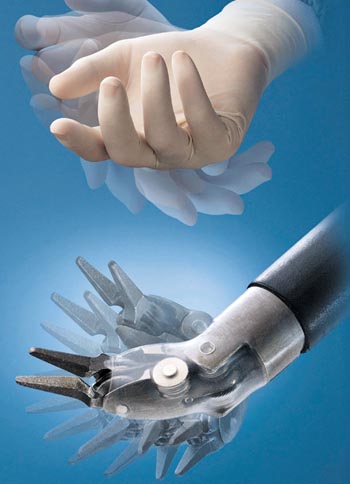Embedded motor control application system in the medical industry
From drug discovery laboratories, radiology departments, to operating rooms, embedded motor control technology in robotics applications is transforming medical research and medical processes.
This article refers to the address: http://
Robotics has deeply influenced new drugs by stably, reliably and reproducibly controlling high-flow liquid-handling systems, detection readers, petri dishes, and a large number of test tubes and vials. The efficiency of research and development. A linear motor, actually called a "straight" motor, has a flat stator that produces linear motion rather than rotational motion. This type of motor is very helpful for accurately arranging various liquids. In addition to precisely arranging sub-microliter quantities of various liquids, these systems can also accurately operate and place large numbers of tubes and vials at the same time. The servo motor can rotate, drive and place a large number of tubes with sufficient precision.
When doctors use medical technology to assist patients with medical diagnosis, the requirements for positioning and motion accuracy are greatly increased. For example, the quality of magnetic resonance imaging (MRI) depends to a large extent on the proper positioning of patients on the MRI rack. Poor positioning can cause tilting of the final image and complicating data interpretation. The motion control system can use a variety of techniques, such as analyzing the motor current offset and using a position decoder to detect if the machine is in contact with the patient, thereby avoiding potential damage to the patient.
Laser eye surgery is more likely to show that this medical process cannot exist without the assistance of a highly accurate machine. This process relies entirely on precise motion control while adding intermittent laser pulses of different intensities. In laser eye surgery, the laser system must track the patient's continuous movement of the eye in real time, and the eye movement speed may reach 100 times per second. The tracking system must be able to keep up with the unintentional rapid movement of the eyeball to ensure that it directs the laser beam to the precise location of the cornea that needs to be modified.
In recent years, robotic surgical assistant devices have been greatly developed. These devices are now even capable of supporting cardiac punctures with a wound of only 1 cm. Laparoscopic surgical assistant robotics, such as those of Intuitive Surgical, do not automate surgery, but rather increase the surgeon's ability to accurately manipulate, dissect, and suture a patient's physiological tissue in a limited external environment during surgery. The company's Endowrist instruments each support a specific surgical task, such as by providing seven degrees of freedom of motion to mimic the flexibility of the human hand and wrist for gripping and stitching.

Intuitive Surgical's laparoscopic robotic system mimics the flexibility of the human hand and wrist.
In standard laparoscopic surgery, the movement of the instrument is counterintuitive, just like looking at a mirror for surgery.
The robotic motion controller maintains a corresponding eye-hand-instrument sequence between the surgeon's hand, the wrist's motion, and the surgical instrument. This reduces the burden on the doctor to learn to use the device, reduces the fatigue of the doctor, and is more conducive to flexible and precise operation. As soon as the surgeon twists the adjustment device clockwise, the robot will twist clockwise. At the same time, the motion controller also filters out the vibration of the doctor's hand.
Although piezoelectric actuators can provide very small displacements, Gary Guthart, senior vice president of Intuitive Surgical, points out that DC servo motors are simple enough, costly, and provide the necessary large driving force – a few pounds of scalpel tip The power to cut the organization.
Due to the sub-millimeter resolution required during surgery, robotics is driving the resolution of DC servo motors. Intuitive's motion control system uses a 1200 Hz control loop to provide sufficient speed and accuracy to make the instrument move faster and more naturally to meet the doctor's expectations.
Another control loop of the robotic surgical assistant device provides the surgeon with basic tactile feedback. The low friction DC servo motor is sufficient to support the Intuitive Surgical robot feedback system. This feedback system provides the surgeon with a sensory interaction with the patient. The motion controller constructs a tactile boundary in the communication interaction with the doctor. In addition to this loop feel, the motion control system uses hardware watchdog and software calculation checks, while using logical consistency checks to ensure security. The system only needs to provide some redundant sensing for error checking and jump into safe mode and notify the surgeon or operator when an error occurs.
These motion-based systems provide a precedent for system designers to continue to find new ways to apply embedded motor control to medical research and medical processes.
Pv Combiner Box,Photovoltaic Combiner Box,Solar Power Combiner Box,Pv Array Combiner Box,Combiner Box
Zhejiang Kaimin Electric Co., Ltd. , https://www.ckmineinverter.com